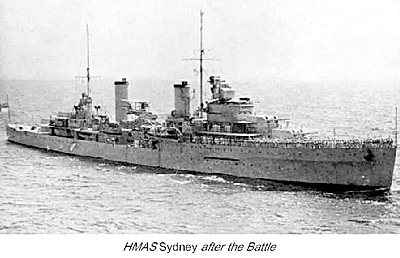
Mr. Sandro Coriasco, a Command at Sea player in Turin, Italy, has sent in the following letter, recommending some changes to the Battle of Cape Spada scenario in Supermarina I. They are backed up by some excellent research.
It took me a bit of time to thoroughly check the data for the battle of Cape Spada (scenario 3 of Supermarina I). At first, my only reference was the book Battaglie Navali nel Mediterraneo durante la Seconda Guerra Mondiale by Arrigo Petacco. In his description of the battle, the distance of the encounter between the CLs and DDs is not precisely stated, but the diagram of the battle and the text induce to think that this happened out of the range of the weapons mounted on the DDs (or, at least, at long/extreme for them ...).
Also, the historical outcome reported in the scenario description states, “At 0620 the Italian cruisers opened fire at long range ...”. Moreover, given the usual aggressive attitude of British naval commanders during the Mediterranean war, if the encounter had really happened at torpedo range, I think they would have “pressed home” the attack, rather than trying to take the Italian CLs under the fire of the more powerful guns of Sydney.
Finally, in my opinion, also the historical 180° (more or less) change of bearing for the DDs wouldn’t be very reasonable at “point blank” distance from the guns of the CLs, which is the situation that the scenario data take to (keeping in mind the victory conditions, too ...).
As a first (failed ...) attempt, I tried to get data from the historical archive of our Marina Militare, but this turned out to be not so easy to access (essentially, I would have had to go there, and from Turin, where I live, to Rome, there are some km: maybe, next time I go on holidays in the area ...).
After some other research, I spotted two reports of the battle on the web.
After reviewing the data there, it looks like the setup distance (18.5 kyds) is the one from which the two formations saw each other (from one of the reports it seems that the CLs saw the DDs even earlier). This is more consistent with the impression of the battle I had from the book above, and it definitely gives the players the chance to recreate the historical outcome.
In the end, I think this is the best scenario of Supermarina I to start with: Not too many units, no planes, few special rules involved (it’s comparable with the Jumpstart scenario, which I find slightly more involved, due to the night situation). This is one of the reasons I decided to spend some time on it.
Setup and special rules modification for the Cape Spada scenario.
I played the scenario as described below four times (once with a referee), and the results were: one British decisive (at the very last die rolls), one British tactical (essentially, the historical result), 2 Italian tactical (one of these was with the one with the referee). The changes in visibility and the “plotting ahead rule” had a relatively important effect on the results (with the Italians trying to “sneak out” of the encirclement, once almost successfully, the other (badly) not, and the British once too daring, the other a bit unlucky.
Start with the same initial positions but with the 40% visibility table. This will allow a detection of the two initial formations at a distance surely closer to the historical one in most of the cases. Even if this will be a bit shorter, it will still be too long for an effective torpedo attack by the DDs, and Sydney will have to intervene for a British victory.
Check for a change of visibility table every 5 Tactical Turns with the tables below. The change indicated in the special rules is simply too slow and predictable. In this way, the approach of Sydney could indeed be “screened by the fog”. Of course, playing with a referee is the best ...
Roll D10 every five Tactical Turns. The chance of the visibility going up or down one table changes with each check.
- 1st check: 0 up 1 table, 1-4 same table, 5-9 decrease 1 table
2nd, 3rd, 4th check: 0-1 up 1 table, 2-7 same table, 8-9 decrease 1 table
5th check: 0-3 up 1 table, 4-8 keep table, 9 decrease 1 table
6th check: 0-4 up 1 table, 5-9 keep same table
from the 7th check on: increase 1 table (up to 75%)
Never go under 25% or over 75% visibility. Interpret such results as “keep the same table.”
Finally, regarding the victory conditions. The Axis tactical victory conditions are not really compatible with the modified scenario. The cruisers can simply turn back west as soon as they see the destroyers, and owing to their speed, there is no chance for the British to catch the Italians.
Modify the Axis tactical victory to:
- “Escape in any direction after being spotted by Sydney with neither Italian cruiser sunk or disabled.”
Or alternatively,
This second condition in particular should force the Italians to close on the destroyers but still gives the British
a chance to get Sydney into the action.
BT
Back to The Naval Sitrep #22 Table of Contents
Back to Naval Sitrep List of Issues
Back to MagWeb Master Magazine List
© Copyright 2002 by Larry Bond and Clash of Arms.
This article appears in MagWeb (Magazine Web) on the Internet World Wide Web.
Other military history and related articles are available at http://www.magweb.com